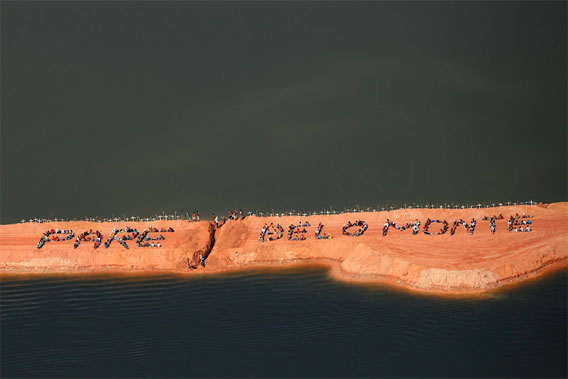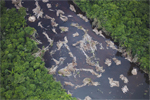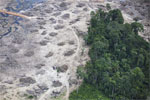
Belo Monte protest: around 300 people dug a channel though an earthen dam blocking the Xingu River last month. Photo credit: Atossa Soltani/ Amazon Watch / Spectral Q.
As of Tuesday, the occupation of Belo Monte dam by indigenous tribes entered its 13th day. Indigenous people, who have fought the planned Brazilian dam for decades, argue that the massive hydroelectric project on the Xingu River will devastate their way of life. According to a statement from the tribes, 17 indigenous villages from 13 ethnic groups are now represented at the occupation, which has successfully scuttled some work on the dam.
The occupiers demand “that construction of the Belo Monte dam be stopped until Norte Energia and the government can adequately mitigate the disastrous impacts of the dam on local indigenous communities,” according to the statement, reprinted by the NGO International Rivers.
Set to be the third largest in the world the dam will displace 16,000 people according to the Brazilian government, although NGOs estimate the total number of displaced will be more than double that.
Final approval of the Belo Monte was given last year, but the physical occupation of the construction site by indigenous tribes corresponded with the Rio+20 Summit on Sustainable Development, which was attended by thousands of government officials from around the world as well as business leaders and NGOs.
For many environmentalists the Belo Monte has also become a symbol of the more than 150 hydroelectric dams planned across the Amazon basin, which they fear could imperil the entire rainforest ecosystem. Although dams are often publicized as ‘green’ sources of energy, they disrupt natural ecosystems and take a toll on wildlife, especially freshwater species. In addition, dams built in the tropics actually expel large amounts of the greenhouse gas methane due to rotting vegetation, which is much more potent in the short-term than carbon. For its part, the Belo Monte will also flood an estimated 40,000 hectares of pristine rainforest and could push some freshwater catfish species to extinction.
Last year, over half a million people worldwide signed a letter protesting the dam, making it the world’s most controversial hydroelectric project.
Related articles
Brazil’s environmental leadership at risk, warn scientists
(06/26/2012) The Brazilian government is putting its global environmental leadership at risk by ignoring scientific concern on large infrastructure projects and changes in the country’s forest laws, warned an association of more than 1,200 tropical scientists gathering last week in Bonito, Brazil on the heels of the disappointing Rio+20 Earth Summit.
Photo: Human canvas on Rio beach protests Brazil’s dam-building spree in the Amazon
(06/20/2012) Nearly 1500 people formed a human banner on a beach in Rio de Janeiro today to protest plans to build dozens of dams in the Amazon basin, reports Amazon Watch, an NGO campaigning against Brazil’s controversial Belo Monte dam.
Protesters dig canal through Belo Monte dam in Brazil (Photos)
(06/16/2012) In an symbolic protest of the giant Belo Monte Dam, Friday morning some 300 locals dug a channel in an earthen dam that blocks a portion of the Xingu River and serves as the first step of the controversial hydroelectric project, reports Amazon Watch.
Tropical dams are a false solution to climate change
(05/27/2012) Tropical dams emit considerably more greenhouse gas emissions than their temperate counterparts yet are being treated as a solution to climate change, warns a report published in Nature Climate Change.
Protesters hit Brazilian mining giant Vale over involvement in Belo Monte
(04/20/2012) More than 150 demonstrators protested outside Vale’s headquarters in Rio de Janeiro during the Brazilian mining giant’s annual shareholder meeting over the company’s social and environmental record, reports Amazon Watch, a group that is fighting the massive Belo Monte dam.
Will mega-dams destroy the Amazon?

(04/18/2012) More than 150 new dams planned across the Amazon basin could significantly disrupt the ecological connectivity of the Amazon River to the Andes with substantial impacts for fish populations, nutrient cycling, and the health of Earth’s largest rainforest, warns a comprehensive study published in the journal PLoS ONE. Scouring public data and submitting information requests to governments, researchers Matt Finer of Save America’s Forests and Clinton Jenkins of North Carolina State University documented plans for new dams in Bolivia, Brazil, Colombia, Ecuador, and Peru.
Pictures: Destruction of the Amazon’s Xingu River begins for Belo Monte Dam

(04/18/2012) The Xingu River will never be the same. Construction of Belo Monte Dam has begun in the Brazilian Amazon, as shown by these photos taken by Greenpeace, some of the first images of the hugely controversial project. Indigenous groups have opposed the dam vigorously for decades, fearing that it will upend their way of life. Environmentalists warn that the impacts of the dam—deforestation, methane emissions, and an irreparable changes to the Xingu River’s ecosystem—far outweigh any benefits. The dam, which would be the world’s third largest, is expected to displace 16,000 people according to the government, though some NGOs put the number at 40,000. The dam will flood over 40,000 hectares of pristine rainforest, an area nearly seven times the size of Manhattan.